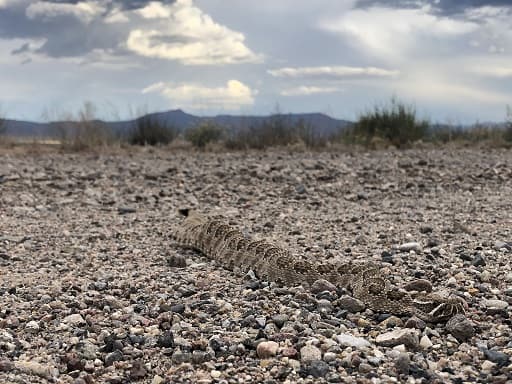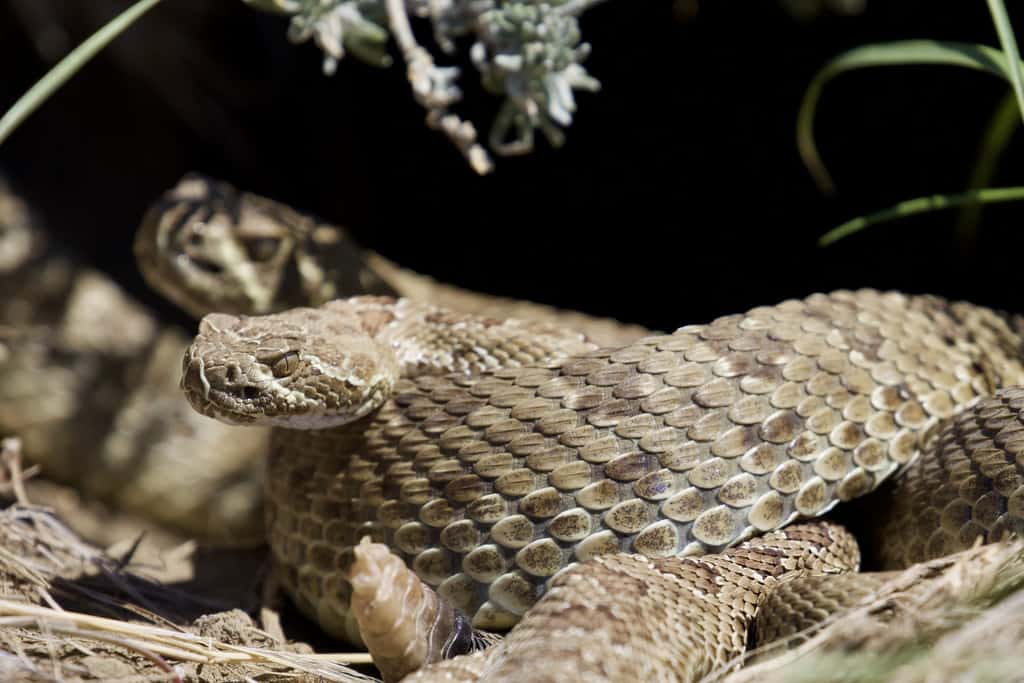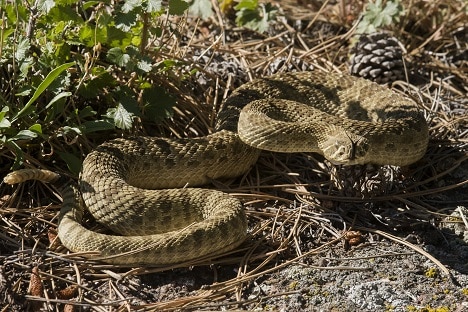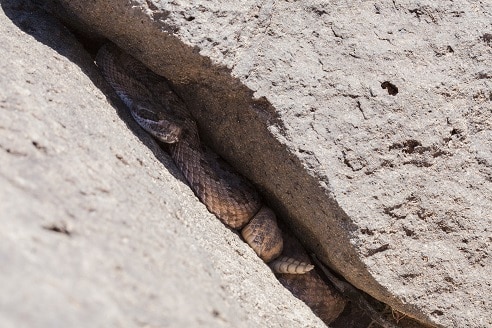| 1 | The Great Plains rattler |

The prairie rattlesnake (Crotalus viridis) isn’t the deadliest rattlesnake of all. It isn’t the longest rattlesnake species, with an average length of 100cm and a record of just 151.5cm (versus 251.5cm for an eastern diamondback). It also lacks any eye-catching physical features, but the prairie rattlesnake does have one claim to fame: being the most widespread of all US rattlesnakes.
The prairie rattlesnake is a species of the US mid-west, occupying Nebraska, Colorado, North and South Dakota, New Mexico and more. They also inhabit northern Mexico and southern states of Canada (Alberta, Saskwatachen). Their main habitat is the vast Great Plains: the never-ending, rocky expanses of short grassland where Native Americans once roamed hunting buffalo.
Prairie rattlesnakes only occur east of the Rocky Mountains, while their close relative the Pacific rattlesnake (Crotalus oreganus) lives to the west. In some states such as South Dakota, prairie rattlesnakes are the sole venomous species. In Canada, they’re one of three, alongside the Pacific and massasauga rattlesnakes.
Prairie rattlesnakes sometimes stray to open forests and grassier meadows, but their favourite locations are easily prairies and wide, rugged grasslands (plus canyons). As you cross another ridge in the Great Plains and look at the next stretch of grassy rolling hills, there could be hundreds of prairie rattlesnakes lying hidden before you.
| 2 | Middling in venom potency |

Prairie rattlesnakes regularly reach 100cm in total length, with an all time record of 151.5cm. Their fangs are 0.56-0.99cm long. This is one of the duller, paler rattlesnakes, ranging from beige to light brown. There are no striking patterns, but their backs are covered with blotches that occasionally join to form rings.
Their belly meanwhile, is free from blotches, and a tan to pale yellow colour in order to disguise themselves in dry surroundings. Their pupils are vertical, and perhaps the only signature feature is a yellow stripe on their head.
At an LD50 score of 1.55mg, prairie rattlesnakes are middling in venom toxicity for their family. The worst is the tiger rattlesnake at 0.06mg, while the western diamondback scores 2.2mg. While deaths aren’t common for prairie rattlesnakes, there’s a few on record, such as 4 year old Helen Moomey, in September 1915, bitten while playing in a park in North Dakota. A recent case (June 2018) was a golfer in South Dakota, who waded into tall grass and was bitten on the ankle. He was driven to the clubhouse in a golf cart, but pronounced dead in Spearfish hospital.
| 3 | How its venom changes with age |
The most interesting thing is how the prairie rattlesnake toxin profile changes with age. At all ages, there’s barely any neurotoxins (unlike tiger rattlesnakes), but as they become adults, the quantity of myotoxins vastly increases. These are muscle-attacking toxins, which cause prey to weaken and stumble around, making escape impossible.
Meanwhile, youths have an abundance of snake venom metalloproteases (SVMPs) in their venom, enzymes which cleave amino acids and dissolve proteins in the skin. These have catastrophic local effects, such as necrosis, peeling and tendon disintegration. These are present in adults, but in lesser quantities.
Scientists have tested the standard rattlesnake antivenin, CroFab, on prairie rattlesnakes and found that it failed against the myotoxins of adults, while succeeding against the SVMPs of youths. Therefore, this difference could make bites harder to treat. CroFab is made from east-diamondback, tiger rattlesnake and cottonmouth venom rather than prairies – no specific antivenin for the prairie rattlesnake exists.
| 4 | Diet: over 90% mammals |

Prairie rattlesnakes have a venom yield of 40-100mg, with Colorado colonies having particularly high amounts. The venom is yellowish, and contains the unique viriditoxin, an acidic protein which adds to the haemorrhagic and myotoxic properties.
The prairie rattlesnake’s diet consists of over 90% mammals. They stick to mammals their entire life, beginning with shrews, voles and mice, before adding large squirrels and prairie dogs as they age. Many diet studies have been conducted, and one in southeastern Alberta tested 20 roadkill prairie rattlesnakes. The sagebrush vole made up 53% of their gut contents, followed by the meadow vole (38%). The olive-backed pocket mouse, western jumping mouse and Richardson’s ground squirrel were also common.
A 2022 study moved to Kansas, and found a calorie count of 29.8% deermice (Peromyscus family) and 17% cottontail rabbits (Sylvilagus family). The oldest study was in 1989, conducted in British Columbia. This found a dietary makeup of 91% rodents, 5% shrews, and 4% birds.
That said, prairie rattlesnakes aren’t massively fussy. In reptiles, they’ve been spotted eating the Texas horned lizard and pygmy short-horned lizard before.
| 5 | Travels epic distances (25km) |
Prairie rattlesnakes begin their yearly life cycle by poking their heads out of hibernation dens in spring. These dens are rocky outcrops, deep rock crevices or mammal burrows, the favourite being prairie dog burrows. Just as Louisiana pinesnakes associate with pocket gophers, prairie rattlesnakes correlate with prairie dogs, and often snuggle up in their burrows after eating them.
Prairie rattlesnakes will venture out, but not fully leave the den until temperatures consistently reach 16 degrees. Then it’s travel time. To find fertile hunting grounds, the prairie rattlesnake embarks on epic voyages across the Great Plains, in a completely straight line. They’re known to travel 5km, 10km or even 25km to find a summer feeding zone, which they’ll then stay in for months without travelling again. These dens are sniffed out using scent alone, carried far over the winds. The goal isn’t to find a few mice straggled around, but a thriving colony where they can grow fat and greedy.
| 6 | Moonlight dodger |
Once prairie rattlesnakes reach the summer feeding zone, they’ll cease travel. They’ll spend hours at a time lying motionless, and only move when hunting or shelter demands it. It’s time to gorge themselves, and their first move is to detect the well-trodden paths of rodents through vegetation.
Prairie rattlesnakes will carefully inspect rocks, litter and debris, predicting where future prey might travel. To hunt, they’ll sometimes cheat and wait directly outside burrows. Their style is a basic bite and pounce system, which the mice will sometimes dodge, and sometimes not. However, prairie rattlesnakes are also crafty hunters in that before a mouse emerges, they’ll inspect vegetation nearby, and flatten a section to create a perfect strike line. At the same time, they’ll leave enough vegetation standing to hide behind, with their vertical pupils peering through. Pacific rattlesnakes (crotalus oreganus) are also famed for this vegetation manipulation.
Prairie rattlesnakes also exploit the Earth’s only satellite, 239,000 miles above in space. A study found that in starlight and dim moonlight, prairie rattlesnakes went on the move, whereas in three quarter or full moonlight, they tended to stay hidden. This rattlesnake has the instinct for camouflage, dodging predators circling above.
| 7 | Remembers its hibernation den |

Another clever trick of the prairie rattlesnake is varying hunting tactics by animal. A study found that with 9 mice tested, they always let them go after envenomation, but with birds, they held onto them 6/9 times. This was presumably so they didn’t fly away. They also injected higher quantities of venom into birds, possibly because their venom is specialised for mammals, or because a bird’s thick feathers are harder to penetrate.
In autumn, prairie rattlesnakes will stay in their summer feeding grounds, but enter breeding mode instead. Finally, it’s time to head home. Prairie rattlesnakes will embark upon the epic 10-25km voyage in reverse, and 95% will return to the exact same hibernation den.
Prairie rattlesnakes can occupy the same rock crevice or vacant burrow for years. Only when temperatures consistently fall to 10C do they vanish for the last time that year. For a couple of weeks, they’ll hang out by the entrance in dwindling light, in an uncertain frame of mind. Prairie rattlesnakes also hibernate with fellow species members, even hundreds at once. All this takes place in remote canyons and Great Plains hills that few ever see.
| 8 | Roadrunner food |
Prairie rattlesnakes are characters in a real-life cartoon: getting hunted by roadrunners (video). The likes of greater roadrunners (Geococcyx californianus) regularly zoom along rocky canyons, scanning the ground with their eager eyes for rattlesnakes to pick up. They have to keep a distance, as the first sign of 20mph feathers causes the rattlesnake to coil up and assume a strike position.
The roadrunner stands back, its eyes never blinking, searching for an opening. When the rattlesnake performs a vicious bluff strike, the roadrunner leaps backwards in a squawking mess of flapping and feathers, before instantly reassuming its focussed hunting position. When hunting, they often raise their feathery tail high in the air behind them. Eventually, its rapid speed will overpower all, and the roadrunner will kill the rattlesnake by picking it up with its beak and clubbing it mercilessly against the ground.
Mountain lions are another occasional predator, as observed in New Mexico on August 12th 2020. Scientists found a 21.8mm tail in the remains of the lion’s meal, and originally considered whether it was a western-diamondback rattlesnake, before concluding that it was crotalus viridis. Prairie rattlesnakes also fall victim to the notorious red-tailed hawk, which also eats gopher snakes.
| 9 | 2 subspecies (formerly 7) |

The prairie rattlesnake became an official species in 1811, after John Bradbury found and described one in Morton County, North Dakota. In the 150 years that followed, the snake acquired a sprawling empire with 7 subspecies. These included the main crotalus viridis viridis, but also c. v. oreganus, c. v. cerberus, and c. v. lutosus.
Scientists suspected for years that it was really several species, and DNA analysis opened the floodgates in 2001. It turned out that only 2 of the subspecies were truly prairie rattlesnakes – the main c. v. viridus, and c. v. nuntius (the Hopi rattlesnake). These were both to the east of the Rocky Mountains, and those to the west became Pacific rattlesnakes, including c.v. oreganus, which had the viridis removed to become the modern crotalus oreganus. C. v. cerberus, meanwhile, became the Arizona black rattlesnake, and this is believed to be the most ancient and ancestral species.
Today, the furthest east that prairie rattlesnakes reach is the Loess hills in Iowa. Their base is the Broken Kettle Grasslands, near Sioux City in Iowa’s far west. In 2017, this colony was reconfirmed after 15 years. After these hills, the prairie rattlesnake fizzles out into nothingness, and the timber rattlesnake and massasauga take over.
| 10 | The Hopi rattlesnake |

Almost all the prairie rattlesnake’s empire is the main subspecies (crotalus viridis viridis). The Hopi rattlesnake, AKA crotalus viridis nuntius is the second subspecies, and lives in just three counties of northern Arizona: Apache, Coconino, and Navajo. It hangs around in rockier areas like canyons, and has noticeably different colours, with brown blotches that stand out more vividly against the pale scales.
However, the hopi rattlesnake is also far smaller than the main prairie rattlesnake. It averages at 60cm, hardly ever exceeding 65cm. One study found that the smallest pregnant female for hopis was 39.5cm, while for the main version it was 58.8cm.
This mini subspecies was worshipped by Native Americans, who considered it to be a messenger to gods of the underworld. Others believe them to be water spirits. The subspecies was originally named after the hopi tribe, who have performed a secretive, elaborate dance for thousands of years. The men sway and twist in rhythm with the rattles, before releasing 4 rattlesnakes in a crossroad of 4 directions, to carry prayers generated from this dance. Other dancers put snakes in their mouths, and wrap the bodies around their necks. The goal is to receive a blessing of torrential monsoons, and full flowing springs, to sustain their parched lands.
